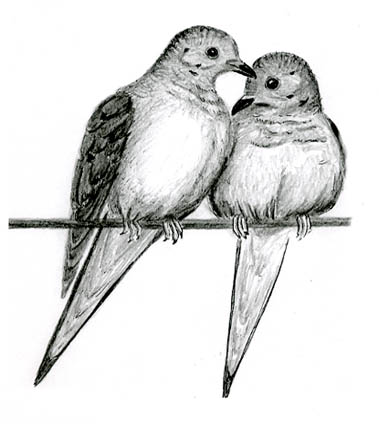
Dear Bird Folks,
“What is a lonesome dove? Also, when a group of doves are feeding on the ground, why will one seem to chase after another? Is a mated dove chasing off a competitor?
-Clay, Huntsville, AL
It’s a “dole” Clay,
Several doves together are called a “dole of doves,” not a “group.” You must be confusing doves with guinea pigs. Several guinea pigs together are referred to as a “group.” (Go ahead and look it up. It’s true.) Don’t worry, it’s a common mistake. While we’re at it you should also know that several finches together are called a “charm,” several penguins are a “parcel” and several toddlers together are called a “mess.” But you knew that.
Now that we have that taken care of, I have one for you. Where did you come up with that lonesome dove question? That’s a question I’ve never had before and I don’t say that very often. There is no species of bird called lonesome dove. It may be the name of a new singles hotline. I’ll have to check. Lonesome Dove is the title of a novel about some retired Texas Rangers who have a ranch in the town of Lonesome Dove. There was also a TV mini-series of the same name, starring Robert Duval and Tommy Lee Jones. They wanted veteran actor Walter Pigeon to be in it, but he had passed away before the mini-series was made. What a shame. He could have been the only Pigeon from Lonesome Dove. Talk about irony.
In your part of the world, Clay, you have several species of doves. Since you weren’t specific I’ll have to assume you are referring to Mourning Doves. I assumed Mourning Doves because they are very common and because that’s the only dove that I actually know something about.
Contrary to their public image as a sign of peace, doves are no more peaceful than any other creature. Sure, much of the time they spend their day bumbling along on the ground or cooing from telephone wires. But when it comes to eating or mating, they can mix it up with the best of them. Doves don’t have big nasty claws or long pointy bills, but that doesn’t stop them from protecting what’s important to them. When another dove crosses “the line” they will stiffen their body and charge. At food sources doves will even charge at other birds and other creatures, including the notorious gray squirrels, causing the squirrels much embarrassment. The squirrels in-turn take out their frustrations on people’s bird feeders. The people then take out their frustrations on the lowly birding store clerk. It’s a vicious cycle that is all started by the dove of peace.
In addition to being braver and more aggressive than most of us realize, doves are also one of the least sexist of all the birds. The male and female both share in nest building, share in the incubation of the eggs and share in the kid raising duties. But that’s not all. Check this out. Most songbirds feed their baby birds insects. The extra protein helps them grow rapidly. Doves are nearly 100% vegetarian, so they don’t have any bugs to offer their babies. To help their young birds grow, the parents secrete a substance from their crop called “pigeon milk”. The milk has the extra protein the little birds need. Both the male and female doves are able to produce this milk and both use it to feed their young birds. That’s right, the male doves produce milk. That’s a trick even male humans can’t do, which is something that I’m very thankful for.
And there’s more. When the breeding season is over, Mourning Doves form flocks. As with other flocking birds, doves have a hierarchy. Some doves are dominant over others. But unlike most birds, dominance is not base upon gender. The male doves do not necessarily dominate the females. If the female dove can stand her ground, she rules.
Their nonsexist life style seems to be working very well for the Mourning Doves. They are one of the most abundant birds in the United States. And if they can find enough food, some doves will even spend their winters in southern Canada. They pay the price for staying up north however. Because of the intense cold these Canadian doves often end up with missing toes, which are lost from either frostbite or from accidents with their hockey skates.
The dove that you saw charging, Clay, was indeed chasing away a “competitor,” just as you suggested. But it’s hard to know for sure if the competitor was after the bird’s food or mate. Or perhaps the aggressive bird you saw was single and it was looking for a mate. If that’s the case you should have it call the new Lonesome Dove singles hotline. I hear they offer a free picture of Walter Pigeon.